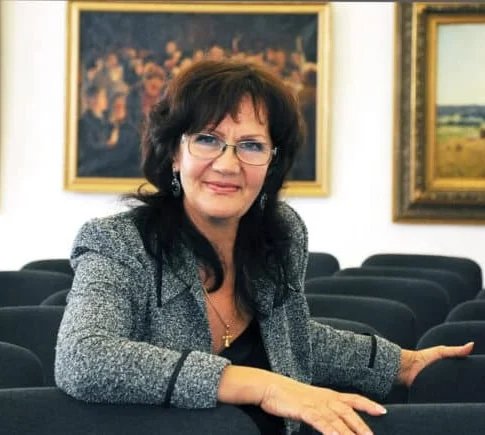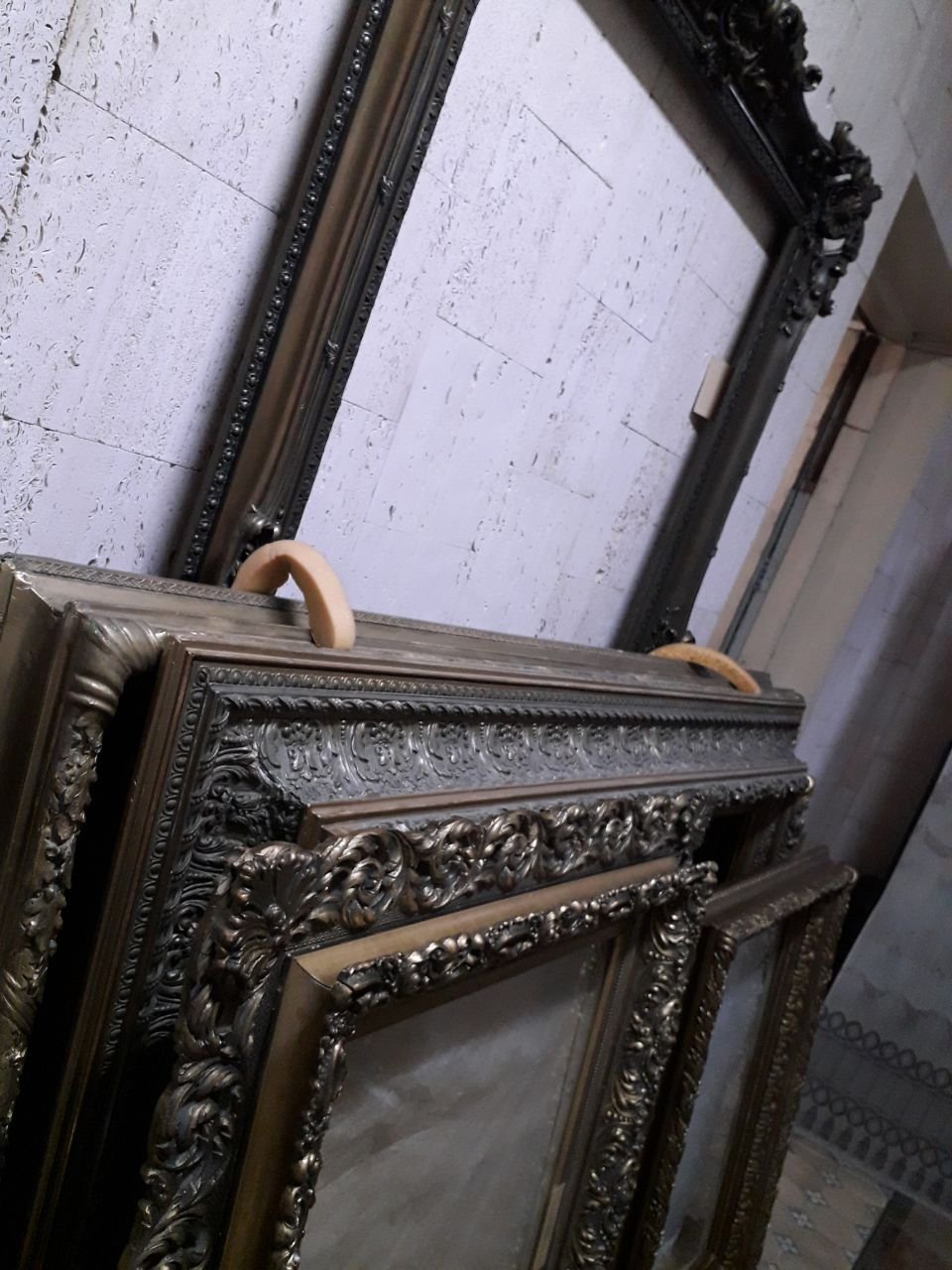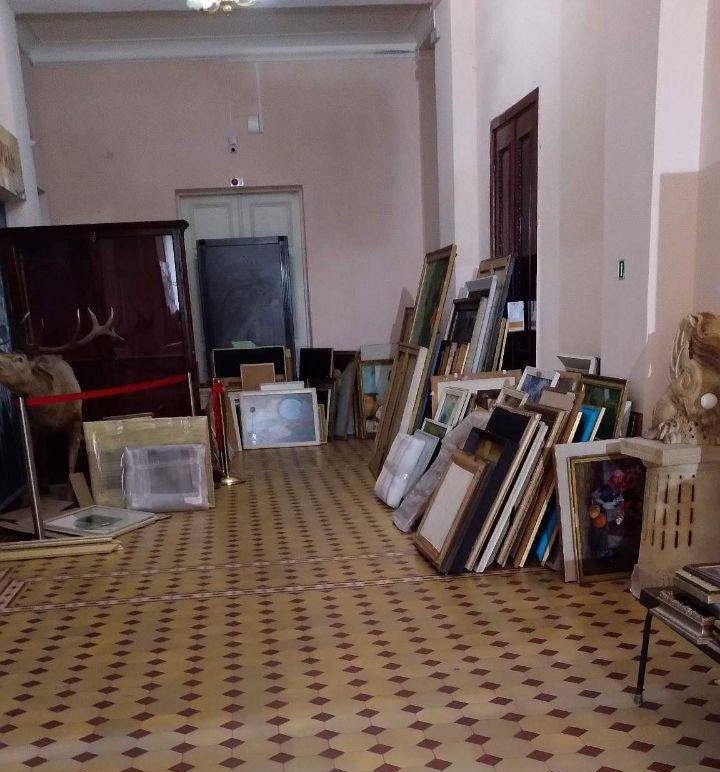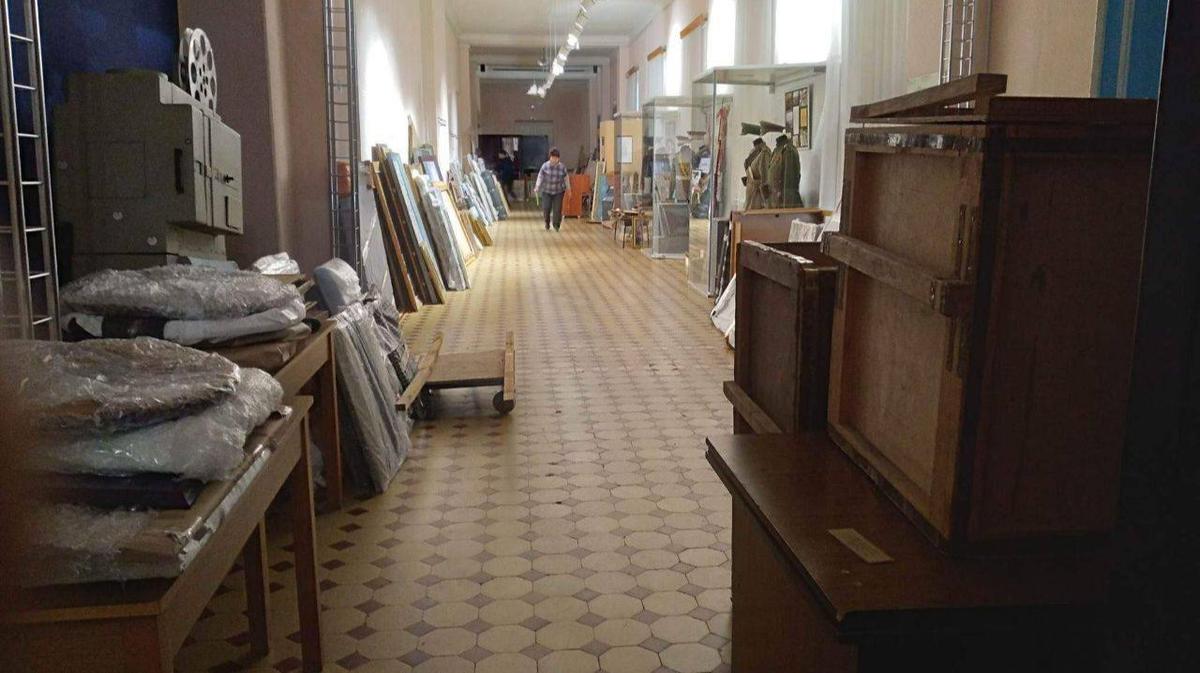On 4 November, Novaya Gazeta Europe reported that the Russia-installed occupation authorities were packing up valuable exhibits of the Kherson Art Museum and transporting them to Crimea. Russian service members guided by local collaborators were rushing to stack museum paintings, books, and sculptures in buses and trucks for five days straight between 31 October and 4 November. Naturally, no one bothered with ensuring that exhibits are properly packaged or maintaining a certain temperature and humidity levels.
“When leaving Kherson, the Russian occupants seized the most valuable exhibits of Kherson’s Regional Museum, Shovkunenko Regional Art Museum as well as Oles Honchar Regional Universal Scientific Library,” said Yuri Sobolevsky, a senior Kherson region official. “They hauled away rare and treasured artworks of the pre-revolution era in the Kherson region, foreign issue collections authored by the Ukrainian diaspora, including works by Taras Shevchenko, Mykola Kulish, and Yevhen Malaniuk. The information resource for all those interested in the history of southern Ukraine has been practically destroyed.”
In total, more than 15,000 pieces have been stolen from Kherson’s foundations and museums, appliances and computers belonging to cultural institutions were seized, while even bathroom fixtures in museums and libraries had been removed. Around 80% of the Kherson Art Museum collection had been looted.
Under siege
“We had a chance to save the collection,” Alyna Dotsenko, director of the Kherson Art Museum, is certain. “We managed to fool the occupants for six months into believing that the whole of Kherson’s museum fund had been evacuated before the war. And we would have definitely held on until the city’s liberation but for traitors among our own employees.”

Director of the Kherson Art Museum Alyna Dotsenko. Photo: Facebook
Russian troops marched into Kherson on 1 March. They also came into the museum, but its halls were empty, while the old building was covered with scaffolding. The museum started a large-scale renovation campaign just before the war broke out.
“This scaffolding around the building and construction materials left behind by a contractor made it possible for us to trick the occupants for quite a while,” Alyna says. “14,500 exhibits were carefully packaged in accordance with all storage rules and hidden in the depository here, in the building, behind iron bars.”
While the military refocused their attention away from the museum to other issues in the city, the museum employees had to address an equally dangerous problem. The construction team that secured the contract to renovate the building abandoned all the works and fled the city on 24 February, leaving behind more than 100 windows wide open.
The employees — Ihor Russol and a few women — had to lug beams, pieces of iron, and bricks upstairs to block up the window frames. It was not an easy task because floor structures were stripped down with only raw beams left in some halls. Ihor was trying to balance at a height of 12-15 metres and was laying down bricks to block off the windows. But gusts of wind were knocking bricks down to rip their way in. Dotsenko appealed to the museum’s supervisory board for help, and one man in Kyiv replied by sending money to a bank account of Hanna Skrypka, a museum employee. However, there was another obstacle: massive queues formed at all ATMs, making it difficult to draw cash. A bank branch manager managed to help the museum to receive the much-needed money, and a local construction brigade was employed to weld the windows shut.
Basement escape
Alyna Dotsenko stayed in her house in a Kherson neighbourhood until 5 May. Large-scale shelling of private housing zones along the Dnipro coast were incessant. In the day, the woman was going to the museum, trying to avoid other employees to not land them into hot water with the occupation authorities. At night, she was hiding in a neighbouring building’s basement to survive. Kherson police officers were also helping by dressing up in civilian clothing and taking Alyna to the museum in someone else’s car. She and the police officers had to act like partisans in an occupied city to continue museum operations.
“The museum, like a bank, likes silence. That’s why we lay low,” she says.
“And we dug deep into the silence and our coverup which helped to protect the museum fund from looting for six months.”
“Was it an act of heroism? Not really. I am at an age where it happens by itself. I read a lot about the Second World War and the partisan movement. On top of that, I am a daughter of a military officer who served in border troops. Despite the fact that my father served in the Soviet army, he was a true Ukrainian. He always underlined that, taught us the Ukrainian language, took us away from people and was singing Ukrainian songs to us, his children. The six-foot-five officer even cried, I remember, when he was forbidden from speaking his native language. And I did not come up with any sophisticated plans, it just happened as it did. I realised that there was no other way, you could not evacuate anything.”

Here’s where one of Ukraine’s most significant collections were stored. Photo: Alyna Dotsenko’s personal archives
On 4 May, someone called Alyna Dotsenko’s landline. An unidentified person suggested organising an exhibition to mark Victory Day (celebrated on 9 May in Russia — translator’s note). The director replied that there was nothing to exhibit and everything was moved out.
“What are you talking about, you have everything,” the man said.
“How do you know?”
“We do know. Your neighbour has already washed a tank (the neighbour is the director of the Kherson Regional Museum located just opposite the Art Museum — author’s note), she is actively preparing [for Victory Day].”
“This is her business, a corrupt one… Why didn’t you even introduce yourself? You know all the information about me, and I don’t know anything about you.”
“Shut it.”
“Well, get lost then.”
“In this case, I’ll be expecting you tomorrow at 10 AM at the commandant's office, we will teach you to respect the new authorities. You need to understand that we are here to stay forever.”
Alyna agreed to have the conversation, but was already on the road early on 5 May. It was dangerous to stay in Kherson any longer because these “invitations” were normally followed by a “basement” which meant torture and possibly death.
“Had I not shown up at the commandant’s office at 10 AM, the military would arrive at my doorstep,” Alyna is certain. “I left in my garden shoes and a house jacket which I wore to go outside. But my body belt had valuable flash drives and documents sewn into it. It took us three days and dirt roads to get to Kyiv.”
Armed museum takeover
On 21 May, six armed men in civilian clothing stormed into the museum. They pointed a gun at a security guard to have him unlock the entrance. Hanna Skrypka kept convincing them that the collection had been moved. She managed to talk the Russians into leaving the museum. The “guests” said that they would come back anyway and if the collection was there, they would take it to Crimea.
FSB and armed masked police officers showed up on 19 July with Natalya Koltsova, head of the exhibition department, and Natalya Desyatova, cafe singer. The latter was introduced as a new museum director. Her first demand? Not to speak to the previous management. She even made employees sign a paper vowing to not communicate with Dotsenko. That is why people started calling Alyna using someone else’s SIM cards.
According to Dotsenko, a police officer disguised as a security guard before he was chased out of the museum saw the keys being taken away from Hanna Skrypka, all storage rooms opened and saw Koltsova running into them and happily exclaiming: “I have been telling you this for 6 months and you didn’t believe me. Look, everything is in its place.’ Skrypka, 52, was put in a car, her phone and documents were confiscated, and then she was taken home for a search.

The collection being unloaded in Simferopol’s Tavrida museum. Photo from Alyna Dotsenko’s personal archive
“When Skrypka returned to the museums, she learnt that the looters were also accompanied by Marina Zhilina, a former museum fund employee, who I fired in late 2021. She brought all the data about the collection from home,” Dotsenko continued. “It turns out that she downloaded all the information and moved it to her home computer while working here. In the beginning of the war, me and Hanna downloaded everything on CDs and cleared out all the information on computers. We hid the CDs in Kherson because I could not carry them across checkpoints. We were certain that even if the thieves were to enter the storage room with 14,000 wrapped and packaged exhibits (in cellophane, latex, foam rubber, and wooden boxes), they would not be able to understand anything. However, the collaborator who had stolen the database helped them out.”
“The occupants also took half of the inventory books. Hanna Skrypka and Ihor Russol hid them under the construction materials across the floors in the beginning of the war. It was impossible to carry the big inventory books out of the museum without being noticed. And also, how do you evacuate them out of the city through all the checkpoints? When the military seized the museum, they went through every corner and found the hideouts.”
“Head of library Halyna Aksyutyna went to the museum to get her personal belongings from her work station after the “new director” was installed. When she was leaving, Koltsova demanded that she be searched. The guards checked her bags but were too shy to do a body search of an elderly woman. So, Halyna managed to save the first original edition of Taras Shevchenko’s Kobzar from the Russian looters. The woman tied the book to her stomach.
Heist
The Russian authorities “evacuated” the Kherson Art Museum between 31 October and 4 November. According to Alyna Dotsenko, Andrey Malgin, director of Simferopol’s Tavrida Regional Museum, led the efforts. Trucks were used to transport the exhibits; the same trucks were later seen near the museum in Simferopol. Concerned people took pictures of the paintings brought to them in a way that codes and inventory numbers of the Kherson museum were visible. This is how the exhibits were identified back in Kherson.
Andrey Malgin confirmed that the exhibits had been taken to Simferopol. “We have 10,000 pieces and we are inventorying them. The Crimean Ministry of Culture arranged for us to keep them here until they tell us otherwise.” According to Malgin, the exhibits are in the museum to “protect” them against war-related damage and stored “in the concert hall, because that is the only place big enough”.
“When I was told that the occupants had looted our museum, I felt really unwell,” Alyna said, holding back tears. “I had to call an ambulance and was on a drip for a few days, constantly crying. No, I was not hysterical, I just did not want to live. The museum was my whole life’s meaning, I’ve been gathering this collection for 45 years. They trampled something that I dedicated my whole life to. But then anger replaced my grief. I am an officer’s daughter and a good sniper. Regretfully, no one gave me weapons even though I asked for them. I would shoot the looters’ legs off. Today, I have no time to grieve, I need to continue working.”
Alyna Dotsenko returned to her museum on 16 November after Kherson was liberated and sappers finished their work. The director saw nothing but empty halls. The occupants stole 80% of the museum’s fund. Employees are currently inventorying what’s left and are appealing to UNESCO and the global community to bring back the stolen collection.
Join us in rebuilding Novaya Gazeta Europe
The Russian government has banned independent media. We were forced to leave our country in order to keep doing our job, telling our readers about what is going on Russia, Ukraine and Europe.
We will continue fighting against warfare and dictatorship. We believe that freedom of speech is the most efficient antidote against tyranny. Support us financially to help us fight for peace and freedom.
By clicking the Support button, you agree to the processing of your personal data.
To cancel a regular donation, please write to [email protected]

